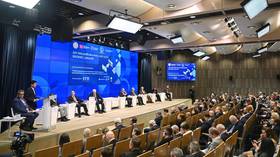Indian investors eye opportunities in Russia’s Far East
Companies from India are exploring opportunities in the pharmaceutical, diamond and hydrocarbons sectors in Russia’s Far East, Deputy Minister for Development of the Russian Far East and Arctic Anatoly Bobrakov told RT on the sidelines of Vibrant Gujarat Global Summit in Gandhinagar, India.
The Far East – which borders the Pacific and Arctic oceans, and spans over four time zones – accounts for one-third of Russia’s coal reserves, mines over 90% of its diamonds, and 50% of its gold.
“The year 2023 witnessed dynamic interactions between the Far East and India, with our turnover growing by 40% over the past year,” Bobrakov said. He added that there were several unexplored areas of cooperation with India apart from traditional sectors, including hydrocarbons, diamonds and timber.
“Several pharmaceutical projects, including plans for the construction of a plant in Sakhalin Region and production in Murmansk Region, were discussed at the forum,” Bobrakov revealed. “There is a significant interest from both sides to develop tourism between India and the Far East.”
The deputy minister also noted Russia’s efforts to develop the Northern Sea Route (NSR) as a new global transportation artery. The route runs from the Barents Sea near Russia’s border with Norway to the Bering Strait between Siberia and Alaska.
“Last year, Russia set a record for cargo transportation through the Northern Sea Route, moving 36 million tons. We are aiming for a total cargo volume of over 220 million tons by 2035,” he said, adding that India is planning to partner with Russia on developing the new route.
Russia has been actively developing the NSR corridor for the past eight years. Moscow plans to launch year-round navigation via the route using its current fleet of nuclear icebreakers, expecting to propel freight turnover that typically is halted from December to May due to thick ice.
Another important maritime route that could boost trade between Russia and India is the Vladivostok-Chennai corridor. “We are actively working on reviving it,” Bobrakov said, adding that later this month a Russian delegation will visit Chennai to discuss specific steps to get the trade corridor up and running.
The agreement establishing the maritime corridor between Chennai and Vladivostok was formally endorsed by the leaders of both nations in 2019, during the Eastern Economic Forum in Vladivostok, which was attended by Indian Prime Minister Narendra Modi. This corridor, which was originally operational during the Soviet era, historically linked Russia’s Far East with India and Southeast Asia. The corridor can be used for transporting diverse cargo types such as coal, oil, liquefied natural gas, and fertilizers.
Where India Meets Russia – We are now on WhatsApp! Follow and share RT India in English and in Hindi













